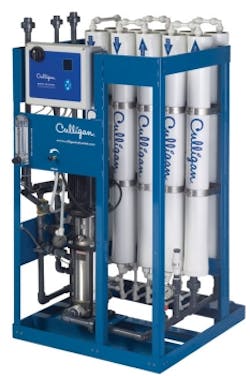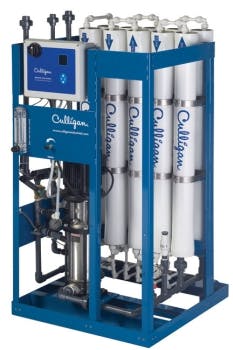Softener, RO Brine Reclaim Minimizes Wastewater
BY ED ORVIDAS
Sustainability initiatives have continued to gain traction throughout nearly all industries and they show no signs of slowing down in the coming year. Likewise, the demand for next-generation solutions that can make meeting sustainability goals easier also continues to grow. An often overlooked opportunity area is the adoption of industrial water treatment solutions that can deliver measurable "green" plant opportunities.
Brine reclaim technology not only "reclaims" system efficiency but also reduces the amount of water and salt that is needed for a typical softener regeneration cycle. With brine reclaim, a portion of reusable brine is returned to the brine tank during softener regeneration. This reduces the amount of salt needed to remove hardness from the water, and the amount of water that is used per each regeneration cycle.
During a typical softener regeneration cycle, a 6-8 percent solution of salt is used to remove the calcium and magnesium ions that are attached to the ion exchange bead. The salt concentration must be high enough to force the sodium to absorb to the resin and break down the calcium and magnesium. Even though the majority of the calcium magnesium is removed during the initial stage of the regeneration cycle, salt is continuously added to get the "polish" and high water quality that is desired.
Conversely, with softener brine reclaim, the amount of salt directed to the brine tank is directly proportional to the amount of salt saved. This can be done by reusing some of the salt in the last part of the brine cycle for the next regeneration. This can lead to a 20-25 percent savings on salt usage as well as a measureable, 20 percent reduction in the volume of wastewater created. In fact, it's not uncommon for companies that have implemented softener brine reclaim to achieve an immediate 20 percent in salt savings and, for those that have been spending $15,000 or more in salt per year, to expect an ROI of one year.
RO Brine Reclaim
RO brine reclaim is ideally suited for manufacturers that impose water limitations on their facilities or for those with very active sustainability programs. For manufacturers with an existing RO unit or nanofilter (which is capable of removing unwanted dissolved ions and filtering out extremely small particles), the addition of brine reclaim technology can result in a 50-60 percent or higher in some cases recovery of wastewater. This high quality water can then be used for other product applications or directed into the boiler for feedwater.
RO brine reclaim also delivers a quantifiable return on investment. For example, because of the high quality of their nanofilter system reject water, a large fruit juice manufacturer was able to reclaim nearly 30 million gallons of water per year, saving $250,000 annually on water and wastewater rates. Likewise, RO brine reclaim can oftentimes pay for itself. In the case of a large beverage manufacturer, the company was able to pay back the costs associated with the addition of an RO unit for brine reclaim based on the volume of reclaimed non-reject water that could be used for boiler feedwater.
Conclusion
Brine reclaim offers an opportunity to reduce waste while increasing cost savings - providing an ideal opportunity for plants to contribute to corporate "green" programs. By implementing brine reclaim technology, manufacturers will see a high ROI due to the reuse of reject water and reduction in salt costs.
About the Author: Edward Orvidas is a Strategic Account Manager at Culligan International. Previously, he spent seven years in field sales with Betz in the industrial water treatment chemical market. Has also has 18 years of water equipment purification experience in a variety of roles with Arrowhead Industrial Water, U.S. Filter and Siemens. Orvidas can be reached at [email protected].

